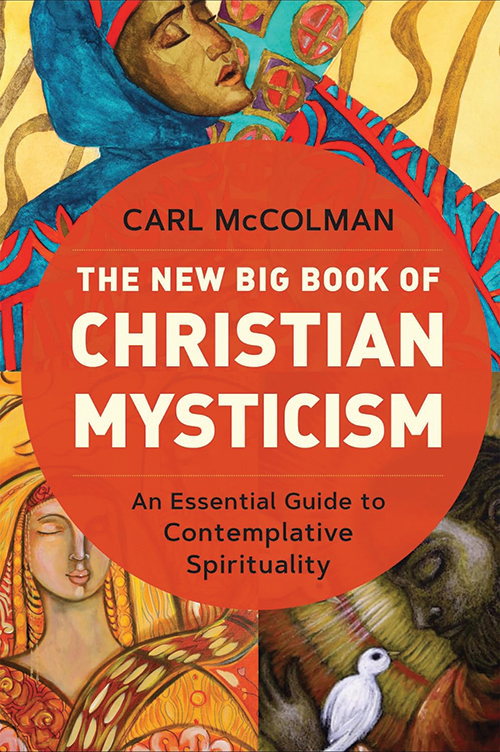
The New Big Book of Christian Mysticism: An Essential Guide to Contemplative Spirituality
Reviewed by Marty Grundy
June 1, 2024
By Carl McColman. Broadleaf Books, 2023. 402 pages. $25.99/paperback; $23.99/eBook.
Although there is no succinct explication of mysticism, Carl McColman identifies it with God’s unconditional love; inclusion of all, especially marginalized people; and the necessity for both individual preparation and a supportive community.
The first part of this book—which is a revised and expanded edition of the author’s 2010 title, The Big Book of Christian Mysticism (Hampton Roads Publishing)—is an extended exploration of mysticism: what it is; where it comes from; how it is experienced and understood; and why it matters. Mysticism is an “embodied encounter with the hidden and mysterious presence of God.” It is “a powerful process for transforming our minds, hearts, and souls.” But also, it “concerns mystery, and the mystery of God cannot be controlled, predicted, engineered, or manipulated.” Although he writes specifically about Christian mysticism, the author willingly looks at mysticism within other faith traditions to find strong similarities and some critical differences.
Part 2 explores how mystical spirituality can be made part of our lives, and its implications. The author assumes that for Christian mysticism one needs to be familiar with Christian religious observance, which provides the matrix for the foundational practices of a mystical life. Although it is by grace—and therefore not in our control—there are things individuals can do to be more open to its possibility. He describes the process as involving “purification, illumination, and union,” not as steps but as cycles, like waves repeatedly crashing and receding, only to come again and again.
Purification, or purgation, is “radically letting-go of everything in our lives that gets in the way of the intimacy with God we desire.” This sounds similar to Frances Taber’s definition of Quaker simplicity in her Pendle Hill pamphlet Finding the Taproot of Simplicity. The book detours into holiness, which is seen not as hard rules but as “living a life of love” within the guidelines of the Ten Commandments (for which McColman offers helpful interpretations) and Jesus’s two commandments (Matt. 22:37–39). “Mystics recognize that we cannot separate the desire to love God from the commandment to love others,” manifesting in work for social justice. Remember that the “quest for holiness is not something we do in order to make ourselves perfect; it is something we do in response to the fact that God already loves us so perfectly.” Being loved ourselves invites and enables us to love others. There is no schism between mysticism and activism.
Illumination means not just giving intellectual assent to “God loves you,” for example, but experiencing that love: somewhat analogous to going from hypothesis to fact through a laboratory experiment. George Fox’s phrase “and this I knew experimentally” (from his Journal) can take on deeper meaning. Preparation for illumination includes “learning the basics of the spiritual life (which, for Christians, includes finding a meaningful spiritual community), and opening our hearts so that the Spirit can cultivate within us the character of holiness.” McColman describes “four essential spiritual practices—Bible reading, prayer, meditation, and contemplation.” Lectio divina and centering prayer are explained and encouraged. But of his 20 “essential mystical prayer practices,” four are specifically Catholic or high church Anglican, while several others need some translation for Friends.
The third part of the process, union or deification, is described as beyond language and into the silence of contemplation. The purpose of contemplation is “to make ourselves available for God and to open ourselves up to the Spirit’s elusive presence.” The “summit of Christian mysticism,” the “unitive life” (quoting Evelyn Underhill), is often referred to in terms of marriage, with becoming one with God.
There is more than can be fit into a short review: the importance of spiritual community, and a spiritual “director”; description of the ideal religious education program; paradox; and the dark night. Much is helpful to Friends, but some is alien.
This book is a mixed bag: an effort at a comprehensive exploration of Christian mysticism but seen almost exclusively through a Roman Catholic lens. There’s an unquestioned assumption that the doctrine of the Trinity is foundational for Christians. Never mind that early Friends, finding no mention of “Trinity” in the Bible, dismissed it as a “notion,” a construction by human minds in their effort to explain the ineffable.
In the annotated reading list, the only Quaker book is Douglas V. Steere’s anthology Quaker Spirituality. The only books written by Quakers in the extensive, nearly 15-page bibliography are Rufus Jones’s Essential Writings, Fox’s Journal, and Steere’s Prayer and Worship. There is no indication that McColman understands or appreciates Friends’ concept and practice of mysticism, let alone the corporate mysticism of a gathered meeting. McColman likes Evelyn Underhill and Howard Thurman—the latter especially dear to Friends. Readers desiring to learn more about Christian mysticism will find much to like, especially in part 1, but Friends wanting a Quaker approach to mysticism will need to do their own translating, especially in part 2.
Marty Grundy, a member of Wellesley (Mass.) Meeting, has had a more apophatic than cataphatic mystical path.
1 thought on “The New Big Book of Christian Mysticism: An Essential Guide to Contemplative Spirituality”
Leave a Reply
Comments on Friendsjournal.org may be used in the Forum of the print magazine and may be edited for length and clarity.



Thanks; sounds like a lot of conditional unconditional love?